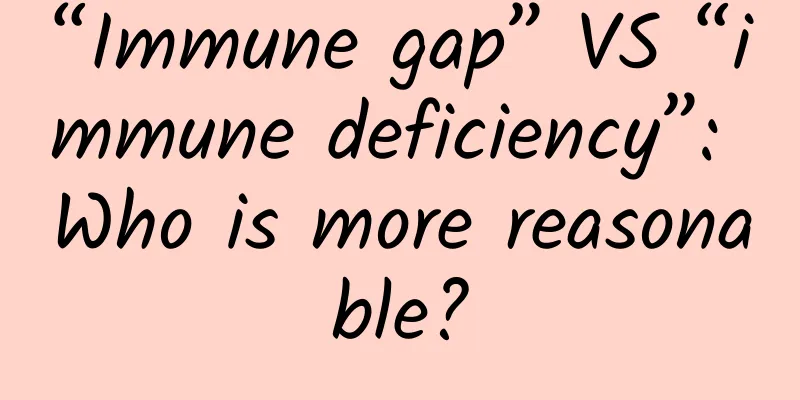“Immune gap” VS “immune deficiency”: Who is more reasonable?

|
The theory that the new coronavirus destroys the human immune system and causes immunodeficiency in patients is difficult to verify and does not conform to general clinical medical knowledge. Written by Li Changqing (Doctor of Medicine, practicing physician in the United States) In response to the surge in respiratory infectious diseases among children this autumn and winter, some experts believe that this is caused by the immunity gap (also known as immunity gap, immunity debt, see "Why are respiratory diseases so rampant this year?") caused by the long-term lockdown of the COVID-19 epidemic. There is no precise definition of the immunity gap, but it was first used to describe the phenomenon of a surge in cases and relatively severe illness in various places during the first respiratory infectious disease epidemic season after the COVID-19 lockdown measures were lifted. This phenomenon has occurred or is occurring in New Zealand (2021), North America (2022), and China (2023), which have successively lifted lockdown measures. The theory of immunity gap is based on the dynamic laws of the spread of various infectious diseases in the population. These laws are not only related to the environment such as weather, but also to the human body's immunity to these diseases. Artificial lockdown measures may break this law, making the spread and clinical manifestations of many infectious diseases unusual. For example, in normal years, many children will be infected with respiratory syncytial virus (RSV) before the age of 2. The lockdown has caused many children to have no chance to come into contact with RSV. If they are suddenly released, the number of children who lack immunity to the virus will multiply, and the average age at which children first come into contact with RSV will be pushed back. The immune systems of children of different ages also respond differently to the virus. The older they are when they first come into contact, the more severe the symptoms may be. Some experts compare the immunity gap to a forest fire. The longer the interval between two fires, the more serious the disaster of the next fire will be. Although supporters of the immunity gap theory have given many theoretical bases, it is almost unprecedented to impose a long-term and large-scale lockdown on an infectious disease, and it is difficult to obtain completely conclusive evidence to support it. Even if the epidemic of a disease in many places can or has been accurately predicted, it does not necessarily mean that it is correct. Some people turned to another theory - immunodeficiency. Those who hold the immunodeficiency theory believe that the increase in the number of respiratory infectious diseases and the worsening of the disease after the relaxation of the restrictions is because most people have been infected with the new coronavirus, which has damaged the human immune system, making people more susceptible to viral and bacterial infections, and the symptoms are more severe. These two theories will have different impacts on the evaluation of the epidemic prevention measures taken by various countries over the past three years, as well as the measures that should be taken to deal with the next regional and global pandemic. If the immunity gap theory is correct, then the next time a new infectious disease occurs, we must consider the possible consequences of strict lockdowns and take measures to minimize interference with normal life and social order while protecting key high-risk groups. If the immune deficiency theory is correct, decision makers will have more reason to take strict epidemic prevention measures. We can compare the two theories from three aspects to see which one is more credible. The first aspect is whether the theory is consistent with medical common sense . The immunity gap theory is more consistent with medical and epidemiological common sense. Although there have been no large-scale lockdowns like the COVID-19 pandemic in the past, the immunity gap phenomenon is very common among individuals. Children who lack outdoor activities and interactions with their peers are more susceptible to infection than their peers once they enter school. The vaccination gap phenomenon is also consistent with this: when the required vaccination rate in a group is not achieved, infectious diseases will resurge, such as the resurgence of measles in some anti-vaccine areas. The immunodeficiency theory is based on the assertion that "the new coronavirus will cause long-term damage to human immunity", which is difficult to verify and does not conform to general clinical medical knowledge. Any respiratory infectious disease will cause some patients to develop severe symptoms, leaving behind damage to the structure and function of the respiratory tract. Difficult-to-repair damage does increase the chance of long-term respiratory infection, but this is a minority of cases and cannot explain the high incidence of a large number of respiratory diseases. Respiratory disease infections within one year are usually not listed among the high-risk factors for respiratory infectious diseases. On the other hand, the COVID-19 virus has a more serious fatality rate, complications, and hospitalization rate in the elderly and those with underlying diseases, while children have milder symptoms and lower risks. If long-term immunity is affected, the elderly should be more affected. However, the reality is that in the first autumn and winter after the lockdown was lifted, pediatric patients were more seriously ill. Some people may say that the excessive immunity caused by the new coronavirus infection can also manifest as immune disorder, which is also a kind of "immunodeficiency". This is theoretically possible. After some acute viral or bacterial infections, some people do develop diseases based on autoimmunity. But this situation basically only occurs in a very small number of people, such as systemic inflammatory reactions in some children after recovery from acute viral infections, and demyelinating diseases mainly manifested in young and middle-aged women. In the early days of the epidemic, some children in Europe and the United States had systemic inflammatory reactions after infection, but statistics later found that the incidence was only a few in a million. The second aspect is the comparison of the accuracy of future predictions . The immunity gap theory has successfully predicted the prevalence of infectious diseases in many regions, and also predicted the trend of infectious diseases gradually returning to the level of previous years in the next few years. The immunodeficiency theory has not made any predictions. According to the pessimistic predictions of its supporters, as long as people do not resume strict prevention and control, the epidemic will continue, and people will face waves of new crown and other respiratory diseases. If this is the prediction, the world has gradually returned to normal life after giving up strict prevention and control, and the epidemics of various respiratory diseases have gradually returned to normal levels. The mortality rate of the new crown is close to or even lower than that of influenza. These realities and data have negated this prediction. The third aspect is the comparison of the authority and reliability of the theories . The immune gap theory comes from authoritative experts and institutions, including experts from the World Health Organization, who also believe that the current peak of respiratory infectious diseases in children in China is caused by the immune gap. The supporters of the immune deficiency theory mostly cite sporadic surveys. The indicators reported in these surveys may reflect changes in the immune system, but the clinical significance is not clear, and there is a lack of related epidemiological surveys. From the current perspective, although the immunity gap theory may not be completely correct, it is the best theory to explain the prevalence of infectious diseases after the epidemic. This theory is in line with the herd immunity theory, which was once stigmatized and many people are reluctant to mention. No matter how stigmatized it is, the world will eventually get out of the epidemic, which is still the result of herd immunity. Neither herd immunity nor the immunity gap theory requires people to deliberately infect themselves with the virus to improve their immunity. Developing and widely vaccinating effective and safe vaccines as quickly as possible is still the key to dealing with infectious diseases. Only in this way can people avoid building herd immunity through natural infection, and avoid filling the immunity gap with a large number of infections after strict prevention and control. This article is supported by the Science Popularization China Starry Sky Project Produced by: China Association for Science and Technology Department of Science Popularization Producer: China Science and Technology Press Co., Ltd., Beijing Zhongke Xinghe Culture Media Co., Ltd. Special Tips 1. Go to the "Featured Column" at the bottom of the menu of the "Fanpu" WeChat public account to read a series of popular science articles on different topics. 2. Fanpu provides a function to search articles by month. Follow the official account and reply with the four-digit year + month, such as "1903", to get the article index for March 2019, and so on. Copyright statement: Personal forwarding is welcome. Any form of media or organization is not allowed to reprint or excerpt without authorization. For reprint authorization, please contact the backstage of the "Fanpu" WeChat public account. |
<<: Assessing the habitability of the Red Planet: Isotopic mysteries in the Martian atmosphere
>>: Cracking the Dark Code: A Treasure Hunt for a Hypothetical Particle
Recommend
Event Promotion Planning: How to organize a complete and efficient event?
This is an era where "content is king"....
The new Apple MacBook is like this?
Will Apple's next MacBook use fingerprint rec...
I heard that sequels dominated the Spring Festival period! Why do movies love to have sequels?
Looking back at the movies during the Spring Fest...
2020 Private Domain Traffic Full Link Practical Operation Guide
Private domain traffic is a mechanism to better s...
New ways to attract traffic through live streaming in 2022
Today, we are not going to talk about “sample fan...
The "penguin on the run" at the zoo? It's actually the top cosplayer in the bird world - the night heron!
At first glance, the above picture seems to be al...
There are two major pitfalls in copywriting that 91% of marketers cannot avoid. Are you one of them?
Marketing can be frustrating sometimes. You have ...
Android 7.0 Nougat's five biggest flaws: no support for floating windows
[[170700]] Introduction: Currently, Android 7.0 N...
China Automobile Dealers Association: Overview and Form Analysis of Used Car Market [Part 2]
This article will continue to share with you some...
Master De Zhang Jiupeng: Will open 500 high-standard automobile service chain enterprises across the country
As the world's largest automobile consumer, c...
Tianfu Chengdu students qt tea tasting arrangement tea drinking at night
Chengdu student tea tasting appointment arrangeme...
10,000-word article analyzing mobile map competitors: Amap, Baidu, Tencent
This article takes the products of the three gian...
How do K12 online education products achieve user growth?
This article mainly discusses the response strate...
The way B station’s information flow ads go viral
The "Most Beautiful Night of 2019" New ...
This preservative commonly found in cakes and breads is actually a "deadly assassin"?
It has been almost half a month since the Mid-Aut...









